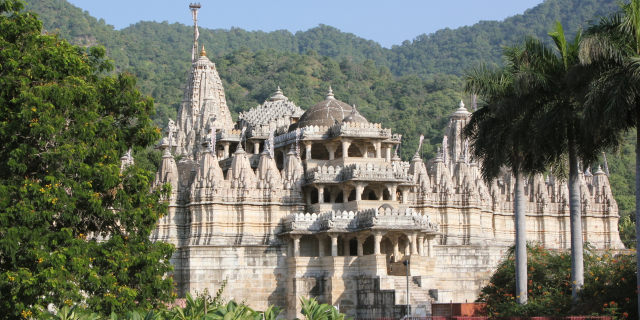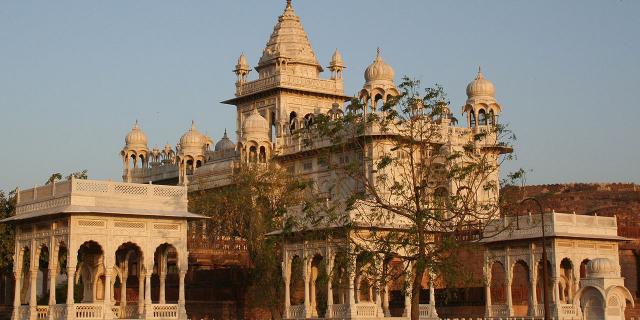सिटी पैलेस, उदयपुर
( City Palace, Udaipur )
City Palace (Raj Mahal), Udaipur is a palace complex situated in the city of Udaipur in the Indian state of Rajasthan. It was built over a period of nearly 400 years, with contributions from several rulers of the Mewar dynasty. Its construction began in 1553, started by Maharana Udai Singh II of the Sisodia Rajput family as he shifted his capital from the erstwhile Chittor to the newfound city of Udaipur. The palace is located on the east bank of Lake Pichola and has several palaces built within its complex.
The City Palace in Udaipur was built in a flamboyant style and is considered the largest of its type in the state of Rajasthan. It was built atop a hill, in a fusion of the Rajasthani Rajput architecture providing a panoramic view of the city and its surroundings. Overlooking Lake Pichola, several historic monuments like the Lake Palace, Jag Mandir, Jagdish Temple, Monsoon Palace, and Neemach Mata temple, are all in the vicinity of th...Read more
City Palace (Raj Mahal), Udaipur is a palace complex situated in the city of Udaipur in the Indian state of Rajasthan. It was built over a period of nearly 400 years, with contributions from several rulers of the Mewar dynasty. Its construction began in 1553, started by Maharana Udai Singh II of the Sisodia Rajput family as he shifted his capital from the erstwhile Chittor to the newfound city of Udaipur. The palace is located on the east bank of Lake Pichola and has several palaces built within its complex.
The City Palace in Udaipur was built in a flamboyant style and is considered the largest of its type in the state of Rajasthan. It was built atop a hill, in a fusion of the Rajasthani Rajput architecture providing a panoramic view of the city and its surroundings. Overlooking Lake Pichola, several historic monuments like the Lake Palace, Jag Mandir, Jagdish Temple, Monsoon Palace, and Neemach Mata temple, are all in the vicinity of the palace complex. Nestled within the Aravali mountain range, these landmarks are also associated with popular culture.
The City Palace was built concurrently with the establishment of the Udaipur city by Maharana Udai Singh II and his successor Maharanas over a period of the next 400 years. The Maharanas lived and administered their kingdom from this palace, thereby making the palace complex an important historic landmark.[1][2]
The Mewar kingdom was flourished initially in Nagda (30 kilometres (19 mi) to the north of Udaipur), established in 568 AD by Guhil, the first Maharana of Mewar. In the 8th century, the capital was moved to Chittor, a hilltop fort from where the Sisodias ruled for 800 years. Maharana Udai Singh II inherited the Mewar kingdom at Chittor in 1537 but by that time there were signs of losing control of the fort in wars with the Mughals. Udai Singh II, therefore, chose the site near Lake Pichola for his new kingdom as the location was well protected on all sides by forests, lakes and the Aravalli hills. He had chosen this site for his new capital, much before the sacking of Chittor by Emperor Akbar, on the advice of a hermit he had met during one of his hunting expeditions.
The earliest royal structure he built here was the Royal courtyard or 'Rai Angan',[3][4][5] which was the beginning of the building of the City Palace complex. The court was built at the location where the hermit had advised Maharana to build his new capital.[2][3][4][5][6]
After Udai Singh's death in 1572, his son Maharana Pratap took the reins of power at Udaipur. Later, in the famous Battle of Haldighati, which end on stalemate against the Mughal Emperor Akbar in the year 1576. After the death of Maharana Pratap, Amar Singh I took the reins of power at Udaipur.
But with the increasing Marathas attacks by 1761, Udaipur and the Mewar state were in dire straits and in ruins. By 1818, Maharana Bhim Singh signed a treaty with the British accepting their protection against the other empires. After the Indian independence in 1947, the Mewar Kingdom, along with other princely states of Rajasthan, merged with the democratic India, in 1949. The Mewar Kings subsequently also lost their special royal privileges and titles. The successive Maharanas, however, retained their ownership of the palaces in Udaipur and converted parts of the palace complex into heritage hotels.
The palace of Udaipur is a glorious symbol of Mewar.































Add new comment